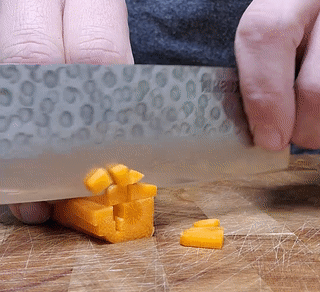Search
Use this section to help customers find the products they're looking for.

Let's be honest, vegetables rank among the most frequently cut ingredients in both commercial kitchens and residential households. While the modern market offers a plethora of knife sizes and shapes, some are better than others. If you're already set on a specific knife, stay open-minded while reading the following, as there are certain models that are more optimal and can open the door to amazing new findings.
Let's break it down into the top three blade styles for vegetables:
Petty
The petty, also known as a kitchen utility knife, is the second most commonly used knife in every kitchen, following the chef's knife which at times can be a little to large. The petty typically ranging between 90mm to 150mm in blade length is an ideal choice for peeling, trimming, and cutting small vegetables such as cucumbers, green beans, spinach, peppers, and more.
So whenever you need to mince herbs or cut soft, small vegetables, the petty will excel, offering delicate precision. However, when it comes to root vegetables or larger ones, you'll require a blade with more cutting power that we will get into below.

Nakiri
The Nakiri knife is widely favored by those who have tried it, yet it is frequently an underestimated style. Originating from Japan, Nakiri translates to "leaf cutter" and is esteemed for its flat profile, facilitating thorough contact with the cutting board.

Ideal for chopping, it has been adapted for contemporary use as the primary chef's knife in vegetable-centric households. The Nakiri excels when used on ingredients such as tomatoes, peppers, ginger, potatoes, onions, herbs and many other small to mid-sized ingredients.

With a blade typically ranging from 160mm to 180mm, it can also manage meats, although its true efficacy lies in push and pull motions rather than the conventional rocking technique associated with many Western knives.
In this modern age, many attempts to replicate shapes can result in a pronounced belly, reducing the full blade contact many users seek. If you get a properly shaped Nakiri, let me tell you, they're worth the investment.
Chef's Knife
Lastly, if you frequently cut root vegetables, you might want to steer away from a thin Nakiri or a small Petty and instead opt for a full-tang blade with a wider spine and longer blade chef's knife allowing for better resistance.
Known as the ideal and most versatile knife in the kitchen, long chef's knives are amazing when you need to cut through large vegetables such as squash, pumpkins, melons, cabbage and most root vegetables that require either a longer blade or one with a more solid construction.

In essence, each of these tree knife models offers its own excellence. However, as you can see the best choice depends on your cutting style and the ingredients you most frequently handle. Therefore, opt for the style that aligns with the majority of your kitchen tasks.

While some may argue that a knife is just a knife, having one tailored precisely to your needs can profoundly impact your overall experience. If you want to learn more about how to choose the best overall kitchen knife, read the following blog: here.
So have you made your decision? Comment below and let us know which blade you think would be the most optimal for your daily vegetable cutting needs.
Use this section to help customers find the products they're looking for.
Leave a comment